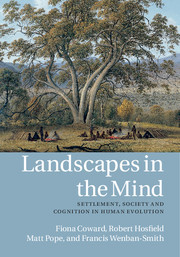Description
Settlement, Society and Cognition in Human Evolution
Landscapes in Mind
Coordinators: Coward Fiona, Hosfield Robert, Pope Matt, Wenban-Smith Francis
This volume provides a narrative of early hominin evolution, linking material aspects of the early archaeological record with social, cognitive and symbolic landscapes.
Language: English
Publication date: 01-2015
440 p. · 18.5x26.1 cm · Hardback
440 p. · 18.5x26.1 cm · Hardback
Description
/li>Contents
/li>Biography
/li>
This volume provides a landscape narrative of early hominin evolution, linking conventional material and geographic aspects of the early archaeological record with wider and more elusive social, cognitive and symbolic landscapes. It seeks to move beyond a limiting notion of early hominin culture and behaviour as dictated solely by the environment to present the early hominin world as the outcome of a dynamic dialogue between the physical environment and its perception and habitation by active agents. This international group of contributors presents theoretically informed yet empirically based perspectives on hominin and human landscapes.
1. What use is the Palaeolithic in promoting new prehistoric narratives? Chris Gosden; 2. Local objects, distant symbols: fission-fusion social systems and the evolution of human cognition Matt Grove and Robin Dunbar; 3. The extension of social relations in time and space during the Palaeolithic and beyond Dwight Read and Sander van der Leeuw; 4. Beyond animality and humanity: landscape, metaphor and identity in the early Upper Palaeolithic of Central Europe Martin Porr; 5. At the heart of the African Acheulean: the physical, social and cognitive landscapes of Kilombe John A. J. Gowlett, James S. Brink, Andy I. R. Herries, Sally Hoare, Isaya Onjala and Stephen M. Rucina; 6. All in a day's work?: early conflicts in expertise, life history and time management Anthony Sinclair; 7. To see a world in a hafted tool: birch-pitch composite technology, cognition and memory in Neanderthals R. M. Wragg Sykes; 8. Ecological niches, technological developments and physical adaptations of early humans in Europe: the handaxe-heidelbergensis hypothesis Nick Ashton; 9. 'Dancing to the rhythms of the biotidal zone': settlement history and culture history in Middle Pleistocene Britain Mark J. White; 10. 'Forest furniture' or 'forest managers'?: on Neanderthal presence in Last Interglacial environments Wil Roebroeks and Corrie C. Bakels; 11. Late Pleistocene hominin adaptations in Greece Paraskevi Elefanti and Gilbert Marshall; 12. In search of group identity: Late Pleistocene foragers in northern China Ofer Bar-Yosef; 13. Handaxe symmetry in the Lower and Middle Palaeolithic: implications for the Acheulean gaze James Cole; 14. Landscapes of the dead: the evolution of human mortuary activity from body to place in Palaeolithic Europe Paul Pettitt; 15. Encoding and decoding the message: the case of mid Upper Palaeolithic female imagery Margherita Mussi; 16. Contextualising the female image: symbols for common ideas and communal identity in Upper Palaeolithic societies Sabine Gaudzinski-Windheuser and Olaf Jöris; 17. Taking a gamble: alternative approaches to the Mesolithic of western Scotland Steven Mithen.
Fiona Coward is Lecturer in Archaeological Science at Bournemouth University. Her research has been published in a variety of journals including Science, the Journal of Archaeological Science and the Cambridge Archaeological Journal, as well as in several edited volumes including The Cognitive Life of Things (2010) and The Sapient Mind (2009). She has been associate editor for archaeology for the Journal of the Royal Anthropological Institute since September 2013.
Robert Hosfield is Associate Professor in Palaeolithic Archaeology at the Department of Archaeology, University of Reading. He has directed excavations in Britain and conducted fieldwork in Sudan. He is co-editor of Quaternary History and Palaeolithic Archaeology in the Axe Valley at Broom (2013). His work has also been published in the Journal of Quaternary Science, Quaternary Science Reviews, the Journal of Archaeological Science and the Proceedings of the Prehistoric Society.
Matt Pope is a Senior Research Fellow at the Institute of Archaeology, University College London. His doctoral research, supervised by Clive Gamble, focused on Lower Palaeolithic archaeology at Boxgrove. He has directed Palaeolithic excavations, including his current investigation of the Neanderthal site of La Cotte de St Brelade, Jersey, and published on early human behaviour. He is a Fellow of the Society of Antiquaries of London and a council member of the Prehistoric Society.
Francis Wenban-Smith is Principal Research Fellow in the Department of Archaeology, University of Southampton. He has directed Palaeolithic investigations at numerous British sites including Swanscombe and Baker's Hole. He led Palaeolithic work for the High Speed 1 rail-link, leading to the monographs The Ebbsfleet Elephant and Prehistoric Ebbsfleet. He has published work in Proceedings of the Prehistoric Society, the Journal of Quaternary Science and the Journal of Archaeological Science, as well as many edited volumes.
Robert Hosfield is Associate Professor in Palaeolithic Archaeology at the Department of Archaeology, University of Reading. He has directed excavations in Britain and conducted fieldwork in Sudan. He is co-editor of Quaternary History and Palaeolithic Archaeology in the Axe Valley at Broom (2013). His work has also been published in the Journal of Quaternary Science, Quaternary Science Reviews, the Journal of Archaeological Science and the Proceedings of the Prehistoric Society.
Matt Pope is a Senior Research Fellow at the Institute of Archaeology, University College London. His doctoral research, supervised by Clive Gamble, focused on Lower Palaeolithic archaeology at Boxgrove. He has directed Palaeolithic excavations, including his current investigation of the Neanderthal site of La Cotte de St Brelade, Jersey, and published on early human behaviour. He is a Fellow of the Society of Antiquaries of London and a council member of the Prehistoric Society.
Francis Wenban-Smith is Principal Research Fellow in the Department of Archaeology, University of Southampton. He has directed Palaeolithic investigations at numerous British sites including Swanscombe and Baker's Hole. He led Palaeolithic work for the High Speed 1 rail-link, leading to the monographs The Ebbsfleet Elephant and Prehistoric Ebbsfleet. He has published work in Proceedings of the Prehistoric Society, the Journal of Quaternary Science and the Journal of Archaeological Science, as well as many edited volumes.
© 2024 LAVOISIER S.A.S.




